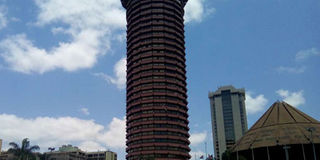Breaking News: At least 10 feared to have drowned in Makueni river
Kenya shines in New York show courtesy of unique buildings

A photo of the KICC taken on September 22, 2016. It is one of the best designed buildings in Kenya. PHOTO | DOUGLAS KIEREINI
What you need to know:
- Wakulima Market is said to have a dramatic quality, which at times almost seems other-worldly.
- The demolition in 2014 of the UFO-shaped New Florida Club — or Mad House, as it was popularly known — is lamented.
NEW YORK
Several prominent buildings in Nairobi are featured in a current exhibit in New York City titled “Architecture of Independence: African Modernism”.
The Kenyatta International Convention Centre gets special attention because the show’s curator, Manuel Herz, suggests it “can be said to encapsulate most of the — partially contradictory — aspects of post-independence architecture in sub-Saharan Africa”.
It was built by a foreign architect, as was the case for most of the 80 buildings included: Kenya, Ghana, Cote d’Ivoire, Senegal and Zambia.
CAPITAL AGENDA
But the “daring design” created by Norway’s Karl Henrik Nostvik “features strongly in the formation of national consciousness” in Kenya, the curator writes in a panel accompanying schematic drawings and photos of the KICC.
Stories from the Daily Nation regarding the building’s construction are reproduced.
Mr Herz recounts the changes in the KICC’s structure that followed from a decision in the late 1960s that it should host a meeting of the World Bank and International Monetary — and not serve as the headquarters of Kanu.
That shift, he maintains, was influential in “aligning the country with a Western and capitalist agenda”.
HOLY FAMILY BASILICA
Mr Herz, an architect with a firm based in Germany and Switzerland, also asks in a text introducing the show whether the KICC and other grand examples of modernism in newly independent African countries should be seen in retrospect as “vanity projects initiated by [an] authoritarian “Big Man”.
Several buildings on the campus of the University of Nairobi are also represented in the exhibit, which runs through to May 27 at the Manhattan-based Centre for Architecture.
Highlighted too is the Holy Family Basilica in which “a breathtaking rainbow of colourful sunlight” is filtered through stained-glass windows.
Wakulima Market, another of the Nairobi landmarks shown in photos, is said to have “a dramatic quality, which at times almost seems other-worldly”.
The demolition in 2014 of the “UFO-shaped” New Florida Club — or Mad House, as it was popularly known — is lamented in a text focused on the adjacent Chai House.
The curator refers to the doomed discotheque as “an architectural masterpiece”.
CONSTRUCTION HALTED
Such examples of “futuristic architecture” mirrored the aspirations and optimistic spirit that prevailed in the years following independence in many African countries, visitors to the exhibit are told.
“A coinciding period of economic boom made elaborate construction methods possible, while the tropical climate allowed for an architecture that blended the inside and outside,” the introductory wall text adds.
But some of the photos and drawings on display also reflect subsequent economic decline and the demise of the hopeful mood of the 1960s.
Construction of the University of Zambia complex was halted midway through six planned phases, a curator’s note points out.
ECONOMIC SETBACK
In Cote d’Ivoire, the plan by strongman Felix Houphouet Boigny for a grandiose African Riviera in an area near the capital city never came to fruition.
It was conceived in 1970 as an international tourism and business destination that would include housing for 120,000 people, along with several schools and a cable car network.
The African Riviera was to be built by an Israeli architectural team, but the project was abandoned in 1973 due to economic setbacks and Cote d’Ivoire’s diplomatic rupture with Israel.





